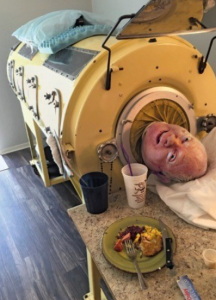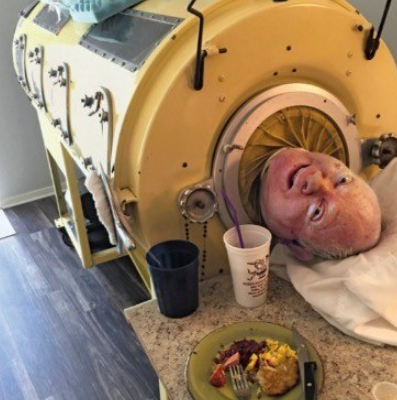
The Breath Between the Bars: Remembering Paul Alexander, the Man in the Iron Lung
It is with profound sorrow and reverence that we mark the passing of Paul Alexander—known to many as “Polio Paul,” “the man in the iron lung,” and to those who followed his story, simply Paul. His death on March 11, 2024, at the age of 78, closes a chapter that spanned nearly eight decades of resilience, intellect, and quiet defiance against the limits imposed by illness and machinery.
Paul’s life was not defined by tragedy, though it began with one. In 1952, at just six years old, he contracted poliomyelitis during one of the most devastating outbreaks in American history. Within days, the virus robbed him of nearly all voluntary movement, leaving him paralyzed from the neck down and unable to breathe on his own. He was rushed to Parkland Hospital in Dallas, where a doctor noticed he had stopped breathing and placed him inside an iron lung—a cylindrical negative pressure ventilator that would become his lifelong companion.
Most people would not survive such a diagnosis, let alone thrive. But Paul did more than survive. He lived.
For nearly 72 years, Paul remained tethered to the iron lung, a relic of mid-century medicine that became both his prison and his sanctuary. While others moved on to modern ventilators, Paul chose to stay with the machine that had saved his life. He learned glossopharyngeal breathing—a technique that allowed him to spend short periods outside the lung—but every night, he returned to its rhythmic hum, its mechanical breath, its steel embrace.
And yet, Paul’s story was never just about the machine.
He earned a bachelor’s degree and a Juris Doctor from the University of Texas at Austin, becoming a practicing attorney in 1986. He wrote legal briefs, counseled clients, and argued cases—all while confined to a device that most people associate with obsolescence. He published a memoir, Three Minutes for a Dog, in 2020, painstakingly typed with a plastic stick or dictated to a friend. He built a following on TikTok late in life, sharing his story with a new generation that had never seen an iron lung, let alone someone who lived inside one.
Paul’s life was a masterclass in reframing limitations. He didn’t just live in the iron lung—he lived beyond it. In his words: “I spent a lot of time in the iron lung, but I didn’t live in it—I lived outside it, in my mind, my heart, and the life I created.” That sentiment echoes like a hymn for anyone who has ever felt trapped by circumstance, illness, or isolation.
His death—reportedly following a hospitalization for COVID-19—feels like the closing of an era. He was one of the last two people in the world still using an iron lung, alongside Martha Lillard. But more than that, he was a living archive of a time when polio ravaged communities, when children were lined up in hospital wards filled with clanking metal lungs, and when survival was measured in breaths borrowed from machines.
Paul’s story reminds us of the terror of polio, yes—but also of the power of vaccines, the importance of public health, and the resilience of the human spirit. He bore witness to a world that changed around him, even as his own physical world remained largely unchanged. He saw the rise of civil rights, the fall of the Berlin Wall, the birth of the internet, and the emergence of social media—all from the vantage point of a machine built in the 1940s.
And yet, he was never behind. He was always ahead—in spirit, in intellect, in grace.
Tributes poured in after his passing. Journalist Kai Kupferschmidt called him “an extraordinary person” whose life was “a reminder of the terror of polio and the power of vaccines.” Christopher Ulmer, who helped fundraise for Paul’s healthcare, said his example “traveled wide and far, positively influencing people around the world.” His brother Philip noted that the support Paul received in his final years allowed him to live “stress-free,” a small mercy for a man who had carried so much.
But perhaps the most powerful tribute is the one we carry in our own hearts—the quiet awe we feel when we imagine a man who lived inside a machine for 70 years and still found ways to love, to learn, to teach, and to laugh.
Paul Alexander was not a symbol. He was a person. And in honoring him, we do not romanticize suffering—we recognize the dignity of endurance, the beauty of adaptation, and the sacredness of every breath.
His life invites us into a communal ritual of reflection. It asks us to co-title the image of a man in an iron lung—not as a relic, but as a witness. Not as a victim, but as a creator. Not as a man who couldn’t move, but as one who moved us all.
So today, we pause. We breathe. We remember.
And we say: Thank you, Paul. For showing us that life is not measured in steps taken, but in meaning made. For proving that even within the confines of steel and silence, one can live a life of thunderous grace.
Rest well, Polio Paul. You were never just the man in the iron lung. You were the breath between the bars.

